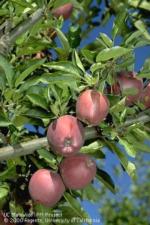Apple (Malus domestica)
Apples are adapted to many areas of California. A cool climate is needed for coloration in most red varieties. Winter chilling requirements for most varieties (except “low chill”) are 1200–1500 hours below 45°F. Foggy days and dews can cause heavy cosmetic russetting on fruit.
There are hundreds of apple varieties, and some varieties have several strains, each with its own characteristics. Spur-type (short shoot growth and abundant spur production) varieties do poorly on dwarfing rootstocks; they are best grown on seedling rootstock. Several rootstocks are available, which impart dwarfing and pest resistance. Apple varieties exhibit considerable genetic diversity. Some require as few as 70 days to mature; others take 180 days or more. Some varieties are very cold hardy; others are tender.
Apples require cross-pollination from another variety that blooms at the same time and produces abundant, viable pollen. Many varieties are self-unfruitful and have sterile pollen; others are partially self- fruitful (not all of their pollen is viable); a few are self-fruitful.
It is best to plant apple trees during January, February, or March.
Calendar of Backyard Gardening Operations for Apples
Winter Dormant Season
- Spray trees with dormant oil to control San Jose scale, aphid eggs, mite eggs.
- Prune 15–20% last year’s growth to let light in.
- Remove diseased/broken limbs.
Spring Bloom Season
- Spray trees with a fungicide to control apple scab and powdery mildew at green tip stage, pink bud stage, and at 10-day intervals thereafter until rain stops.
- Thin apples by hand within 30–69 days after full bloom to about 1 per 6" of shoot growth.
- Fertilize prior to first irrigation. Mature trees: use 2 lb. urea or 40 lb. manure spread on the surface.
Summer Growing Season
- Fertilize young irrigated trees monthly (April–July). Use 8 oz. urea or 20 lb. manure/tree. Water in. Do not exceed 1 oz. urea/emitter/appl.
- Spray (May 1 – September 1) to control codling moth worms; time sprays to visual ID of worm holes in fruit.
- Control aphids if damage exceeds 50% leaves crinkled and aphids present.
- Control mites if damage is severe.
- Drip irrigate daily or sprinkler irrigate every 2–3 weeks.
Fall Harvest Season
- Continue irrigating.
- Fertilize mature trees after harvest. Repeat rates from summer.
- At leaf fall, remove and destroy or compost leaves to prevent the spread of apple scab.
- Control weeds throughout the entire season with an organic mulch.
Resources
- Apple Links, UC Fruit and Nut RIC
- [PDF] Apple Varieties for Planting in the Home Garden, Paul Vossen, Sonoma and Marin Co. UCCE
- [PDF] Apples and Pears: Calendar of Operations for Home Gardeners, Pamela M. Geisel and Carolyn L. Unruh, Fresno County and Paul Vossen, Sonoma and Marin County
- [PDF] Apple Scab, UC IPM
- [PDF] Apples: Safe Methods to Store, Preserve, and Enjoy, Linda Harris, Sylvia Yada, Elizabeth Mitcham
- [PDF] Guidelines to Evaluate Apples for Commercial Planting in the Sierra Nevada Foothills, Dick Bethell, El Dorado Co. UCCE
- [PDF] Harvest Time for Selected Fruit Cultivars in the Sacramento Valley Foothills, Janine Hasey, Sutter-Yuba Cos. UCCE
- How to Manage Pests in Gardens and Landscapes - Fruits and Nuts, UC IPM
